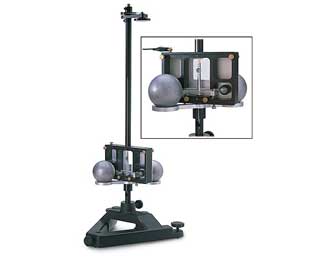Cavendish Balance, 1L10.30
Location:
Cabinet: Mechanics (ME) (Will be permanently installed in lecture halls eventually)
Bay: (B12)
Shelf: #1
 (photo from Pasco online)
(photo from Pasco online)
Description:
Two small lead balls are attached to a cross-beam which is suspended by a fine wire to form a torsion pendulum. Two large lead spheres are placed opposite the small balls to exert a force onto the suspended system.
Equipment |
Location |
ID Number |
|
|
|
Cavendish Balance |
ME, Bay B12, Shelf #1 |
1L10.30 |
Laser |
... |
... |
Setup:
- Setup requires 48 hour advanced notice before lecture. (Once the Cavendishes are installed in the room this condition may be lifted.)
- Level the Cavendish Torsion Balance on a vibrational free platform.
- The two large lead spheres are then placed opposite the smaller balls
- The system must then be allow to reach equilibrium, this takes a few hours.
- Adjust a laser so that the beam strikes the mirror mounted on the torsion balance, but missing the large outer sphere, and hitting the wall opposite the Cavendish.
Cautions, Warnings, or Safety Concerns:
- The large masses are made of lead and weight about 1.5Kg
- The torsion balance inside the Cavendish is very delicate and must be handled carefully. Also carry by its base.
- The beam of the laser can harm the eye. Make sure that the beam is out of harms way.
Demonstration:
The objective of this experiment is to determine a numerical value for Newton's constant, G. F = (GmM) / (r2). The two large lead spheres are then moved to the opposite position from the initial setup position. This exerts a torque which moves the cross-beam torsion wire system. Now let the system come to a new equilibrium position which is shown by a laser beam reflected off a small mirror that is attached to the cross-beam torsion wire system. The laser dot is reflected to the opposite wall and hence the motion of the cross-beam can be observed and measured. The finial equilibrium position will take several hours as the simple harmonic motion of the torsion pendulum damps out.
- The two smaller masses have a mass: m=38g
- The center-to center distance between of the smaller ball: L=50.0mm.
- The two larger masses have a mass: M=1.5Kg
Each of the small masses experiences the force F at a distance L / 2 from the axis of the balance and this force is proportional to the deflection of torsion balance beam from its equilibrium position. From this one can drive Newton's constant without F. G = [2π2Lr2) / (MT2)] θ Where L is the center-to-center distance between of the smaller ball. The center-to-center distance of the large mass to the small mass when balance is deflected is r. The period of oscillation of the balance is T.
attachment other photos |
attachment other photos |
attachment other photos |
attachment other photos |
References: